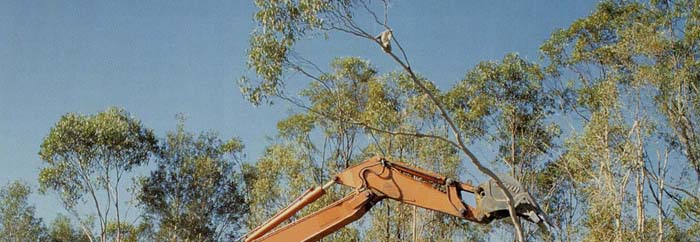‘Habitat’ refers to the types of bushland that Koalas like to live in. They are found in a range of habitats, from coastal islands and tall eucalypt forests to low inland woodlands. Today they do not live in rainforest, although it is thought that millions of years ago the ancestors from which today’s Koalas evolved lived in the rainforests which covered much of Australia at that time.

Koala populations only occur if suitable habitat is available. The two most important factors which make habitats suitable are (1) the presence of tree species preferred by Koalas (usually eucalypts, but also some non-eucalypts) growing in particular associations on suitable soils with adequate rainfall and (2) the presence of other Koalas.
Research shows that socially stable Koala populations occur only when there are primary (or favourite) tree species present. Even if a selection of tree species known to be used by Koalas occurs within an area, it will not support a Koala population, or at least the Koala population will not use it, unless one or two favourite species are present.
This is one reason why it is not a good idea to rely on a general list of preferred Koala food trees. Leaving out the key species from tree plantings to restore Koala habitat, could be a waste of time and effort.
With the latest research, it is becoming clear that the Koalas’ selection of tree species influences the social structure of populations and the maintenance of each individual Koala’s home range within the population. A greater understanding of the Koala’s behaviour is a very important factor when identifying suitable Koala habitat. Planning for future protection and management of Koala habitat needs to take such factors into consideration.
Koalas live in societies, just like humans, so they need to be able to come into contact with other Koalas. Because of this they need to have areas of suitable eucalypt forest which are large enough to support a healthy Koala population and to allow for expansion by maturing young Koalas.
What is happening to koala habitat?
Since European settlement, approximately 80% of Koala habitat has been decimated. Of the remaining 20% almost none is protected and most occurs on privately-owned land.
Settlers have favoured the rich fertile lands along the eastern seaboard to have their farms and urban developments. Unfortunately, this is where the majority of Koalas are already living because they also like to live in trees which are growing in fertile soils.

How habitat destruction affects koalas
Before we can find ways to solve some of the Koala’s problems, it is important first to understand the relationship between the Koala and its environment. To best appreciate the effect of habitat loss on Koalas, imagine yourself as a Koala and how you would feel in a similar situation.
Imagine someone knocked down your home, as well as most of the houses and roads in your neighbourhood. How would you feel when you arrived home to find your house was gone and nothing in your street was familiar? You would feel sad, angry, worried, confused and depressed. Then imagine how you would feel if you couldn’t get to a shop to buy any food. You would begin to get very hungry and if you didn’t find somewhere to sleep and rest, before long you would be in a very sorry state. Koalas experience feelings like these when their habitat is cleared to make way for a new road, housing estate or farm. If they do manage to survive the clearing, finding a new home has its problems, too. If the area is already built up, Koalas will face dangers like disorientation (feeling lost), cars, dog attacks and swimming pools. Unless they have access to a safe haven of undisturbed habitat large enough to support a Koala colony, their days as suburban Koalas are numbered. Scientists have found that Koalas facing these sorts of problems are more prone to disease. They also have a lower rate of reproduction.

Click here for more information on the effects loss of habitat has on koalas

